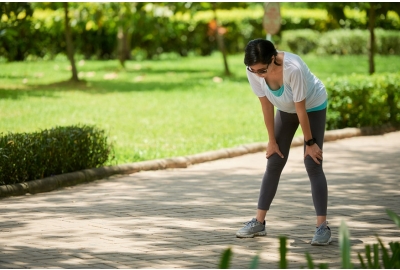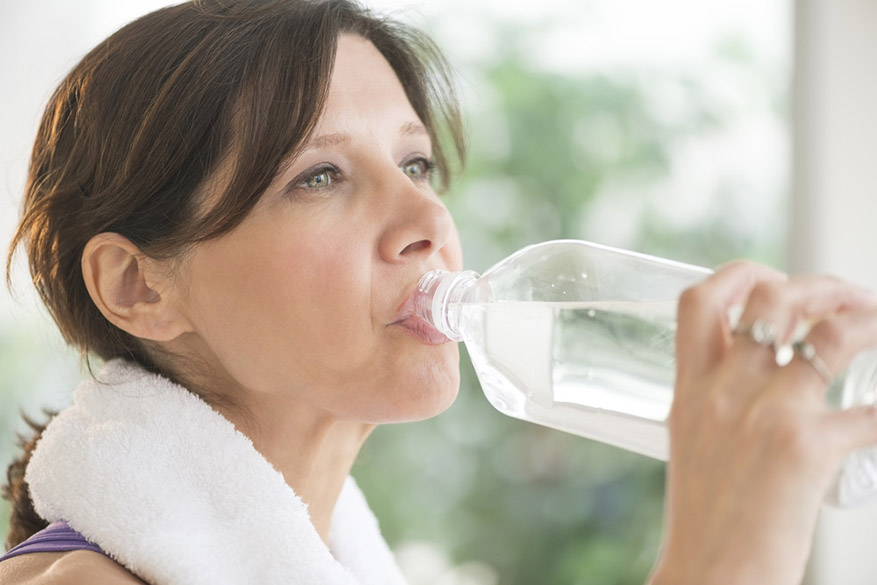
Why Do I Pee When I Jump and Work Out?

By Dragon Images/Shutterstock.com
Having a little bit of bladder leakage when you work out is more common than you might think. In fact, during an interview with a Sofia & Grace user, she said, “jumping jacks specifically cause some leakage.” This falls under a type of bladder leakage known as stress incontinence, meaning that your bladder leaks when subjected to physical stressors (such as peeing while jumping). About 15 million women in the U.S. experience stress incontinence, so you’re definitely not alone.
Exercising puts a lot of stress on your body, especially high impact workouts. As you move around, intra-abdominal pressure pushes on your bladder. If your pelvic floor muscles or your sphincter (the muscle that holds the urethra closed) is already weak, you may experience leakage once that extra pressure hits. Other activities, such as lifting, bending, sneezing, or coughing, can also create that extra pressure and trigger bladder leakage.
Pregnancy and childbirth is the most common cause of weak pelvic floor muscles, but it’s not the only one. Gynecological surgery can also cause it, while menopause, obesity, and chronic coughing can also raise your risk of developing it.
Thankfully, there are many things you can do to help reduce your chances of urinating while working out. Here are nine helpful tips, from managing leaks to strengthening your muscles.
- Wear dark, loose clothes. The darker the clothes, the less they show liquid stains, so you should definitely wear darker pants for working out. Opt for looser fitting bottoms, which will keep your bladder leakage pads from being as noticeable. If you prefer tighter-fitting leggings, choose a thicker material that won’t show the lines of your underwear or pad.
- Try bladder leakage pads. Similar to pads for menstruation, these absorbent pads stick to your underwear and catch bladder leakage. Wearing bladder leakage pads can give you the confidence to keep exercising in the short-term while you work on some longer-term solutions to improve your incontinence.
- Use the bathroom before. Try to empty your bladder right before starting your workout, even if you don’t feel like you have to go to the bathroom. Starting with an empty bladder will reduce your chances of surprise leakage in the middle of an exercise class.

By tmcphotos / Shutterstock.com
- Watch your fluid intake. You should drink enough water to stay hydrated, but try not to guzzle a lot of fluids during and after your workout. Your body can only absorb so much fluid so fast, and the excess will go straight to your bladder, creating the urge to urinate and upping your chances of an incontinence incident.
- Be mindful of what you eat. Spicy or highly acidic foods can irritate your bladder, reducing your bladder control and increasing your chances of bladder leakage. Instead, try to eat more mild, high fiber foods that won’t irritate your stomach or bladder (not to mention help keep you regular).
- Wear a tampon. If you’re in a pinch, putting in a tampon can put some pressure on the urethra, keeping it closed and preventing leaks. If removing a dry tampon is painful due to the extra friction, you can moisten the area with water or a vaginal lubricant to help it slide out.
- Try a pessary. A pessary is a device designed to help hold vaginal tissues in the correct shape after a prolapsed uterus. The pessary keeps the tissues from laying on the bladder and causing even more pressure than usual. If you have a prolapsed uterus, talk to your doctor about what kind of pessary might work best for you.

By Olga Gorkovtseva / Shutterstock.com
- Build your pelvic floor muscles. Sometimes, incontinence may be caused by weak pelvic floor muscles. If that’s the case for you, you can rebuild the muscles by doing pelvic floor exercises, such as Kegels. If you have trouble feeling your muscles done there, Kegel balls can help you identify and target them, so you’re actually working your pelvic floor and not your abdominals.
- Consider bladder training. If your bladder leakage during workouts is caused by urge incontinence rather than stress incontinence, you have another tool in your arsenal. Bladder training — increasing the intervals between your bathroom trips — can help you manage urge incontinence and overcome the psychological urge to urinate. Your doctor will be able to help you determine what type of incontinence you have and whether or not bladder training could help.
Urinating when you jump or work out may feel embarrassing, but it’s more common than you’d think. But just because stress incontinence is common doesn’t mean that you have to stop your favorite workouts, or that you’ll deal with it for the rest of your life. Follow these tips to manage your bladder leakage during workouts so you can continue to do the exercise you love.